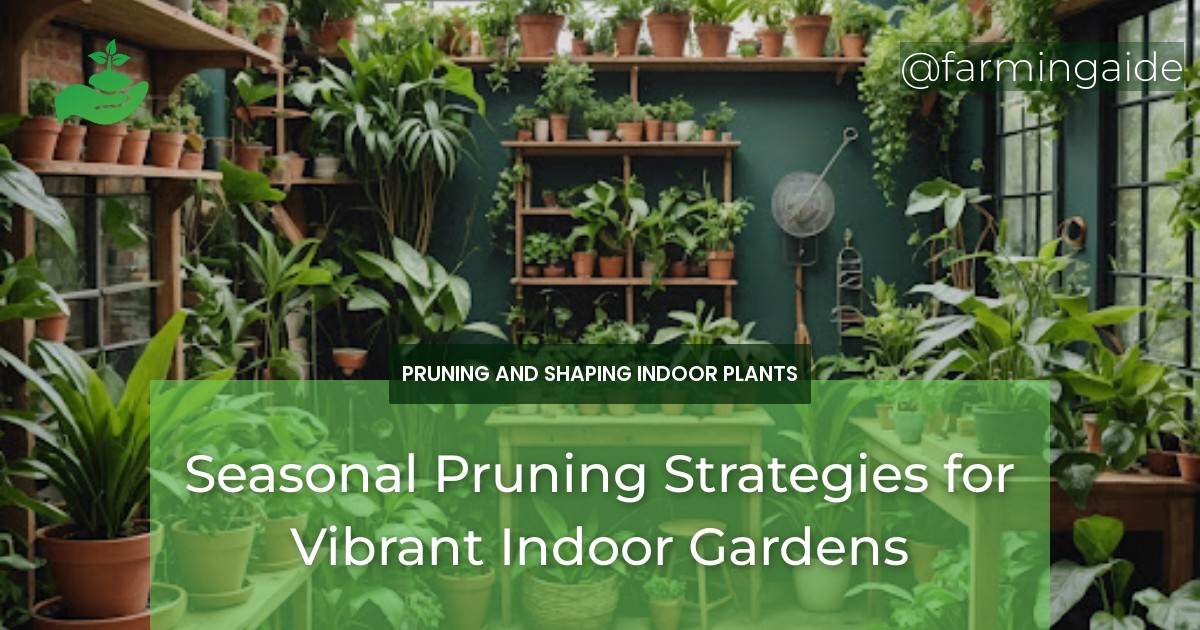As the seasons change, so do the needs of your indoor garden. To keep your plants thriving and vibrant, it’s essential to prune them regularly. Pruning is not just about cutting back overgrown branches; it’s an art that requires attention to detail and a deep understanding of your plants’ needs. In this article, we’ll explore the importance of seasonal pruning, the benefits it provides, and the techniques to use for each season. By the end of this journey, you’ll be equipped with the knowledge to prune like a pro and enjoy a lush, healthy, and thriving indoor garden.
Key Takeaways
- Seasonal pruning is crucial for maintaining plant health and promoting growth.
- Understanding the basics of pruning techniques and tools is essential for successful pruning.
- Pruning in spring, summer, fall, and winter requires different techniques and strategies.
- Pruning can increase air circulation, reduce plant stress, and promote healthy growth.
- A well-pruned indoor garden is more resistant to pests and diseases.
Understanding Seasonal Pruning
Before we dive into the specifics of seasonal pruning, it’s essential to understand the importance of pruning in general. Pruning is a vital gardening technique that involves cutting or removing certain parts of a plant to promote healthy growth, increase yields, and enhance its appearance. Pruning can be used to control the size and shape of plants, encourage fruiting and flowering, and remove dead or diseased branches.
Seasonal pruning takes this concept a step further by tailoring pruning techniques to the specific needs of plants during different times of the year. By pruning at the right time and using the right techniques, you can help your plants thrive and overcome the challenges posed by changing seasons.
Importance of Seasonal Pruning
Seasonal pruning is crucial for maintaining plant health and promoting growth. When done correctly, pruning can:
- Increase air circulation and reduce humidity, reducing the risk of fungal diseases.
- Encourage healthy growth and promote fruiting and flowering.
- Remove dead or diseased branches, preventing the spread of disease.
- Improve the overall appearance of your plants, making them more aesthetically pleasing.
Basic Pruning Techniques
Before we dive into the specifics of seasonal pruning, it’s essential to understand the basic pruning techniques. These include:
Thinning: Removing selected branches to allow more air and light to reach the remaining branches.
Heading: Cutting the tip of a branch to encourage bushy growth.
Pinching: Removing the tip of a branch to encourage branching.
Pruning tools: Using the right tools, such as pruning shears, loppers, and pruning saws, is essential for successful pruning.
Spring Pruning for Growth
Spring is the perfect time to prune your indoor plants to promote healthy growth and encourage new development. During this season, focus on:
ALSO READ
Pruning Flowering Plants in Spring
Flowering plants, such as African Violets and Begonias, require special care during the spring season. To encourage blooming, prune back leggy stems, remove dead flowers, and provide support for new growth.
Use the following techniques to prune flowering plants in spring:
- Cut back leggy stems to encourage branching.
- Remove dead flowers to encourage new blooms.
- Provide support for new growth using stakes or trellises.
Tools and Techniques for Spring Pruning
In the spring, it’s essential to use the right tools and techniques to prune your plants effectively. Use:
Pruning shears for delicate stems and branches.
Loppers for thicker branches and stems.
Pruning saws for large branches and stems.
| Tool | Use |
|---|---|
| Pruning shears | Delicate stems and branches |
| Loppers | Thicker branches and stems |
| Pruning saws | Large branches and stems |
Summer Pruning for Health
During the summer season, the focus shifts from promoting growth to maintaining plant health. Prune your plants to:
ALSO READ
Pruning to Encourage Air Circulation
Good air circulation is essential for healthy plant growth. Prune your plants to:
Remove any branches that are touching or crossing.
Thin out dense foliage to improve air circulation.
Managing Overgrowth in Summer
Summer is the perfect time to manage overgrowth and prevent your plants from becoming leggy. Prune back:
Leggy stems to encourage branching.
Overgrown branches to maintain shape and size.
Fall Pruning for Preparation
As the seasons change, it’s essential to prepare your plants for the colder months. Prune your plants to:
Pruning to Prepare for Winter
Prune your plants to prepare them for the winter season. Remove:
Dead or diseased branches to prevent the spread of disease.
Weak or damaged branches to promote healthy growth.
Reducing Plant Stress in Fall
Fall pruning can help reduce plant stress by:
Reducing the risk of disease and pests.
Improving air circulation and reducing humidity.
Winter Pruning for Maintenance
During the winter season, prune your plants to maintain their health and promote healthy growth. Focus on:
Pruning Dormant Plants
Prune dormant plants to maintain their shape and size. Remove:
Dead or diseased branches.
Crossing or rubbing branches.
Essential Winter Care Tips
In addition to pruning, provide your plants with:
Reduced watering to prevent root rot.
Bright, indirect light to promote healthy growth.
Conclusion: Year-Round Pruning for a Vibrant Garden
In conclusion, seasonal pruning is a vital technique for maintaining a vibrant and healthy indoor garden. By understanding the basics of pruning, using the right tools and techniques, and adapting to the changing seasons, you can create a thriving indoor oasis. Remember to prune with purpose, prune with care, and prune with the seasons to enjoy a lush, healthy, and thriving indoor garden.


